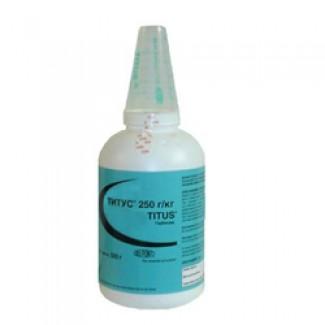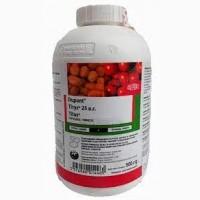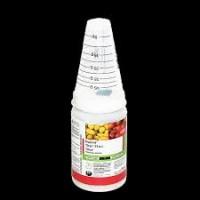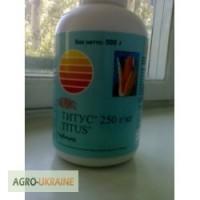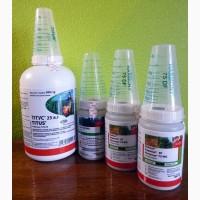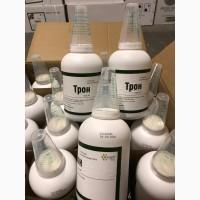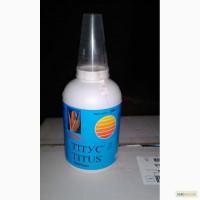Sell / buy
Buy herbicide Titus, Kirovohrad region.
Price511.18$
Region:all of Ukraine,
Kirovohrad region.
(Kropivnytskyi )
Updated:
Agriculture today is one of the most important, if not the most important, type of activity that provides functioning of the entire country. No matter how it sounds, but in such a difficult economic, political, and financial period, agrarians are obliged to stand up and provide results. The cultivation of potatoes and tomatoes occupies a considerable niche in the entire agricultural economy. It is logical that the choice of effective SZR should be rational. DuPont, the world leader, presents a new product for the control of cereal (annual and perennial) weeds and a wide range of dicot pests - Titus herbicide. This is a reliable post-emergence preparation that allows you to control the weediness of potato and tomato crops.
The mechanism of action of the herbicide
The systemic effect of the drug is possible due to its active ingredient - rimsulfuron, which belongs to the group of sulfonylureas. Titus is absorbed mainly through the leaf plates and partly through the root system of the plant, from where the movement to the growth points begins. By inhibiting acetolactate synthase, rimsulfuron prevents the biosynthesis of important amino acids - valine and isoleucine, thereby blocking the crushing of weed cells and their development. In fact, the herbicidal effect begins a few hours after spraying, but it is invisible to humans. The first noticeable symptoms of weed suppression appear after a few days. The plant dies completely after 2-3 weeks after applying Titus. The herbicide may affect less sensitive weed plants by partial inhibition. This guarantees the absence of competition with culture and, thus, the reduction of their negative influence. For the maximum effect, it is necessary to carry out spraying in a certain growing season of the weed. So, to suppress wheatgrass and gum, Titus is applied once when the weeds do not exceed 15-30 cm in height, the growing season is no earlier than 3 leaves. To control cereal weeds, processing should be carried out at the stage of 1-3 leaves, before tillering, and dicotyledons should be treated at 2-4 leaves. After 2-3 weeks, repeated introduction is possible.
Regulation of application on potatoes
Both single and double application of Titus herbicide is permissible on potatoes. The application option is selected based on the weediness of the fields and types of weeds. The maximum permissible dose of the product is 50 g/ha, it is used to control creeping wheatgrass. Potatoes are processed once only after sprouting, when the growth level of the shoots is from 5 cm to 20 cm. The consumption of the product with this version of spraying is 40-50 g/ha. Be sure to use Trend 90 surfactant at the rate of 200-300 ml/ha together with Titus.The adhesive ensures a uniform coating. If the scheme of two-time application of Titus is selected, then the consumption of the herbicide is as follows: at the first application after hilling, at a growth level of potato shoots of 5-20 cm, use 30 g/ha of Titus together with 200-300 ml/ha of surfactant Trend 90 and partner pesticide if necessary. The second treatment is carried out at the moment of the appearance of the next wave of weeds in a dosage of 20-30 g/ha of Titus with 200-300 ml/ha of adhesive. Titus is highly selective not only for tomatoes, but also for all varieties of potatoes. Rarely, minor damage is possible on certain types of culture, on fresh leaves. They manifest themselves in the form of yellowing or the so-called "marbling" of the leaf, and they pass quite quickly on their own. Similar phenomena do not have a negative impact on the overall yield of potatoes, and the quality of the seed material does not suffer.(//tractor-service.com)
Regulation of application on tomatoes
To protect tomatoes, Titus is allowed to be used in several variants. This includes pre-sowing application, spraying in the early phases of vegetation - the cotyledon stage, use in a later period - in the 2-6 leaf stage. Such a wide application window is possible due to the high selectivity of Titus for tomatoes and the ability to reveal their potential. Two-time spraying of tomatoes is also allowed, in other countries I practice using Titus before the germination of seed varieties, including for irrigation. The amount of herbicide for processing seeded tomatoes is 50 g of the drug per 1 ha in combination with the surfactant Trend 90 at the rate of 200-300 ml/ha. Titus is introduced after the crop has germinated, during the cotyledon period - two real leaves. If necessary, repeated spraying is carried out after 1-2 weeks at the rate of 40-50 g/ha of the drug. Seedling tomatoes are processed after they are planted in open ground, not earlier than after 6-10 days, focusing on the beginning of the next weed wave. The dosage is similar – 50 g/ha Titus + 200-300 ml/ha Trend 90. Repeated application is allowed 1-2 weeks after the first. Herbicide consumption in this case is 40-50 g per 1 ha, surfactant Trend 90 without changes.
Titus and tank mixtures
The product is a good partner for tank mixes, which are used both to protect tomatoes and potatoes. Recommended combinations with other metribuzin-based herbicides, in particular Zencor, can significantly expand the range of controlled weeds. In the areas clogged with species of cycad, common sedge, solanum, garden purslane, mountain birch, and smoke, the drug-partner is applied at the rate of 0.2-0.3 l/ha (Zenkor). For complex protection, it is also possible to use Titus withfungicides. Recommended – Thanos or Furzat. The manufacturer does not recommend using the herbicide within 7 days before or after spraying the culture with organophosphorusinsecticides. Under normal conditions, the product decomposes quickly in the soil, the average half-life is up to two weeks. A certain soil herbicidal effect was noted after processing the Titus fields under conditions of high soil moisture and cool weather. In other words, in such weather conditions, a single application of herbicide is able to control the undulation of weed germination.
Tips and Warnings
For best performance, the manufacturer recommends following the following tips. Warm, dry weather is optimal for spraying. In case of excessive dryness and heat, the maximum rate of working solution should be used - 300 l/ha, PAV Trend 90 is also applied at the rate of 300 ml/ha. Processing is carried out early in the morning or in the evening, avoiding demolition on neighboring crops. During the preparation of the working fluid, Titus is poured in first, and then Trend 90 and, if necessary, a partner drug. The average volume of solution is 200-300 liters per 1 ha. In a situation of serious overgrowth of harmful plants, the maximum volume is used. Fields are not sprayed at temperatures below 6 °C and above 25 °C. Crops that are in a state of stress due to the influence of pesticides or weather conditions, damaged by pathogens and phytogens should not be processed. Precipitation that fell within 2-3 hours after spraying can reduce the effectiveness of the herbicide. Therefore, if such a forecast is expected, the processing is postponed. Accordingly, it is not carried out immediately after them on wet crops or on dew.
The mechanism of action of the herbicide
The systemic effect of the drug is possible due to its active ingredient - rimsulfuron, which belongs to the group of sulfonylureas. Titus is absorbed mainly through the leaf plates and partly through the root system of the plant, from where the movement to the growth points begins. By inhibiting acetolactate synthase, rimsulfuron prevents the biosynthesis of important amino acids - valine and isoleucine, thereby blocking the crushing of weed cells and their development. In fact, the herbicidal effect begins a few hours after spraying, but it is invisible to humans. The first noticeable symptoms of weed suppression appear after a few days. The plant dies completely after 2-3 weeks after applying Titus. The herbicide may affect less sensitive weed plants by partial inhibition. This guarantees the absence of competition with culture and, thus, the reduction of their negative influence. For the maximum effect, it is necessary to carry out spraying in a certain growing season of the weed. So, to suppress wheatgrass and gum, Titus is applied once when the weeds do not exceed 15-30 cm in height, the growing season is no earlier than 3 leaves. To control cereal weeds, processing should be carried out at the stage of 1-3 leaves, before tillering, and dicotyledons should be treated at 2-4 leaves. After 2-3 weeks, repeated introduction is possible.
Regulation of application on potatoes
Both single and double application of Titus herbicide is permissible on potatoes. The application option is selected based on the weediness of the fields and types of weeds. The maximum permissible dose of the product is 50 g/ha, it is used to control creeping wheatgrass. Potatoes are processed once only after sprouting, when the growth level of the shoots is from 5 cm to 20 cm. The consumption of the product with this version of spraying is 40-50 g/ha. Be sure to use Trend 90 surfactant at the rate of 200-300 ml/ha together with Titus.The adhesive ensures a uniform coating. If the scheme of two-time application of Titus is selected, then the consumption of the herbicide is as follows: at the first application after hilling, at a growth level of potato shoots of 5-20 cm, use 30 g/ha of Titus together with 200-300 ml/ha of surfactant Trend 90 and partner pesticide if necessary. The second treatment is carried out at the moment of the appearance of the next wave of weeds in a dosage of 20-30 g/ha of Titus with 200-300 ml/ha of adhesive. Titus is highly selective not only for tomatoes, but also for all varieties of potatoes. Rarely, minor damage is possible on certain types of culture, on fresh leaves. They manifest themselves in the form of yellowing or the so-called "marbling" of the leaf, and they pass quite quickly on their own. Similar phenomena do not have a negative impact on the overall yield of potatoes, and the quality of the seed material does not suffer.(//tractor-service.com)
Regulation of application on tomatoes
To protect tomatoes, Titus is allowed to be used in several variants. This includes pre-sowing application, spraying in the early phases of vegetation - the cotyledon stage, use in a later period - in the 2-6 leaf stage. Such a wide application window is possible due to the high selectivity of Titus for tomatoes and the ability to reveal their potential. Two-time spraying of tomatoes is also allowed, in other countries I practice using Titus before the germination of seed varieties, including for irrigation. The amount of herbicide for processing seeded tomatoes is 50 g of the drug per 1 ha in combination with the surfactant Trend 90 at the rate of 200-300 ml/ha. Titus is introduced after the crop has germinated, during the cotyledon period - two real leaves. If necessary, repeated spraying is carried out after 1-2 weeks at the rate of 40-50 g/ha of the drug. Seedling tomatoes are processed after they are planted in open ground, not earlier than after 6-10 days, focusing on the beginning of the next weed wave. The dosage is similar – 50 g/ha Titus + 200-300 ml/ha Trend 90. Repeated application is allowed 1-2 weeks after the first. Herbicide consumption in this case is 40-50 g per 1 ha, surfactant Trend 90 without changes.
Titus and tank mixtures
The product is a good partner for tank mixes, which are used both to protect tomatoes and potatoes. Recommended combinations with other metribuzin-based herbicides, in particular Zencor, can significantly expand the range of controlled weeds. In the areas clogged with species of cycad, common sedge, solanum, garden purslane, mountain birch, and smoke, the drug-partner is applied at the rate of 0.2-0.3 l/ha (Zenkor). For complex protection, it is also possible to use Titus withfungicides. Recommended – Thanos or Furzat. The manufacturer does not recommend using the herbicide within 7 days before or after spraying the culture with organophosphorusinsecticides. Under normal conditions, the product decomposes quickly in the soil, the average half-life is up to two weeks. A certain soil herbicidal effect was noted after processing the Titus fields under conditions of high soil moisture and cool weather. In other words, in such weather conditions, a single application of herbicide is able to control the undulation of weed germination.
Tips and Warnings
For best performance, the manufacturer recommends following the following tips. Warm, dry weather is optimal for spraying. In case of excessive dryness and heat, the maximum rate of working solution should be used - 300 l/ha, PAV Trend 90 is also applied at the rate of 300 ml/ha. Processing is carried out early in the morning or in the evening, avoiding demolition on neighboring crops. During the preparation of the working fluid, Titus is poured in first, and then Trend 90 and, if necessary, a partner drug. The average volume of solution is 200-300 liters per 1 ha. In a situation of serious overgrowth of harmful plants, the maximum volume is used. Fields are not sprayed at temperatures below 6 °C and above 25 °C. Crops that are in a state of stress due to the influence of pesticides or weather conditions, damaged by pathogens and phytogens should not be processed. Precipitation that fell within 2-3 hours after spraying can reduce the effectiveness of the herbicide. Therefore, if such a forecast is expected, the processing is postponed. Accordingly, it is not carried out immediately after them on wet crops or on dew.
|
Shop, contacts | |
Olexiy / || |173отзывы, инфо. / activity evaluation | |
|
Phone:
+380xxxxxx
show
| |
All user ads ~89 | |
ID ads: #832970
(added by a registered user, registration date: 07-18-2018)
Added/Updated: 05-03-2024 10:43
(relevant, until: 03-05-2025)
Permanent ad address:
Showed / watched for today: ?, total: ?
Similar ads
Among them there are many interesting...
